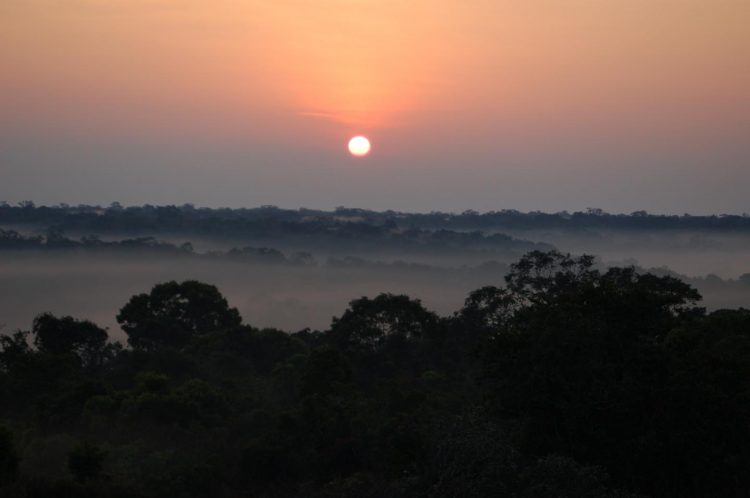Warm nights could flood the atmosphere with carbon under climate change

A study led by Princeton University researchers suggests that hotter nights may wield more influence than previously thought over the planet's atmosphere as global temperatures rise -- and could eventually lead to more carbon flooding the atmosphere. The researchers determined that warm nighttime temperatures, specifically in the tropics, lead plants to release more carbon through a process known as respiration. Average nighttime temperatures in tropical regions such as Manaus, Brazil, (above) have risen by 0.6 degrees Celsius since 1959. Further temperature increases risk turning Earth's land-based carbon-storage capacity, or sink, into a carbon source. Credit: William Anderegg, Princeton Environmental Institute.
Since measurements began in 1959, nighttime temperatures in the tropics have had a strong influence over year-to-year shifts in the land's carbon-storage capacity, or “sink,” the researchers report in the journal Proceedings of the National Academy of Sciences. Earth's ecosystems absorb about a quarter of carbon from the atmosphere, and tropical forests account for about one-third of land-based plant productivity.
During the past 50 years, the land-based carbon sink's “interannual variability” has grown by 50 to 100 percent, the researchers found. The researchers used climate- and satellite-imaging data to determine which of various climate factors — including rainfall, drought and daytime temperatures — had the most effect on the carbon sink's swings. They found the strongest association with variations in tropical nighttime temperatures, which have risen by about 0.6 degrees Celsius (33 degrees Fahrenheit) since 1959.
First author William Anderegg, an associate research scholar in the Princeton Environmental Institute, explained that he and his colleagues determined that warm nighttime temperatures lead plants to put more carbon into the atmosphere through a process known as respiration.
Just as warm nights make people more active, so too does it for plants. Although plants take up carbon dioxide from the atmosphere, they also internally consume sugars to stay alive. That process, known as respiration, produces carbon dioxide, which plants step up in warm weather, Anderegg said. The researchers found that yearly variations in the carbon sink strongly correlated with variations in plant respiration.
“When you heat up a system, biological processes tend to increase,” Anderegg said. “At hotter temperatures, plant respiration rates go up and this is what's happening during hot nights. Plants lose a lot more carbon than they would during cooler nights.”
Previous research has shown that nighttime temperatures have risen significantly faster as a result of climate change than daytime temperatures, Anderegg said. This means that in future climate scenarios respiration rates could increase to the point that the land is putting more carbon into the atmosphere than it's taking out of it, “which would be disastrous,” he said.
Of course, plants consume carbon dioxide as a part of photosynthesis, during which they convert sunlight into energy. While photosynthesis also is sensitive to rises in temperature, it only happens during the day, whereas respiration occurs at all hours and thus is more sensitive to nighttime warming, Anderegg said.
“Nighttime temperatures have been increasing faster than daytime temperatures and will continue to rise faster,” Anderegg said. “This suggests that tropical ecosystems might be more vulnerable to climate change than previously thought, risking crossing the threshold from a carbon sink to a carbon source. But there's certainly potential for plants to acclimate their respiration rates and that's an area that needs future study.”
###
This research was supported by the National Science Foundation MacroSystems Biology Grant (EF-1340270), RAPID Grant (DEB-1249256) and EAGER Grant (1550932); and a National Oceanic and Atmospheric Administration (NOAA) Climate and Global Change postdoctoral fellowship administered by the University Corporation of Atmospheric Research.
William R. L. Anderegg, Ashley P. Ballantyne, W. Kolby Smith, Joseph Majkut, Sam Rabin, Claudie Beaulieu, Richard Birdsey, John P. Dunne, Richard A. Houghton, Ranga B. Myneni, Yude Pan, Jorge L. Sarmiento,? Nathan Serota, Elena Shevliakova, Pieter Tan and Stephen W. Pacala. ” Tropical nighttime warming as a dominant driver of variability in the terrestrial carbon sink.” Proceedings of the National Academy of Sciences, published online in-advance of print Dec. 7 2015. DOI: 10.1073/pnas.1521479112
Media Contact
All latest news from the category: Earth Sciences
Earth Sciences (also referred to as Geosciences), which deals with basic issues surrounding our planet, plays a vital role in the area of energy and raw materials supply.
Earth Sciences comprises subjects such as geology, geography, geological informatics, paleontology, mineralogy, petrography, crystallography, geophysics, geodesy, glaciology, cartography, photogrammetry, meteorology and seismology, early-warning systems, earthquake research and polar research.
Newest articles

New Study Offers Hope for Chronic Pain Relief in Dialysis Patients
People undergoing hemodialysis treatment for kidney failure often experience chronic pain related to their condition, but it can be difficult to manage with opioid medication and other conventional treatments. A…

Early Adult Mortality Surges in Post-COVID US
New research from Boston University School of Public Health and the University of Minnesota shows that death rates for early adults, or adults aged 25-44, rose sharply during the COVID-19…

Recycling Lithium-Ion Batteries Boosts Supply Chain Resilience
Recycling lithium-ion batteries to recover their critical metals has significantly lower environmental impacts than mining virgin metals, according to a new Stanford University lifecycle analysis published in Nature Communications. On…



